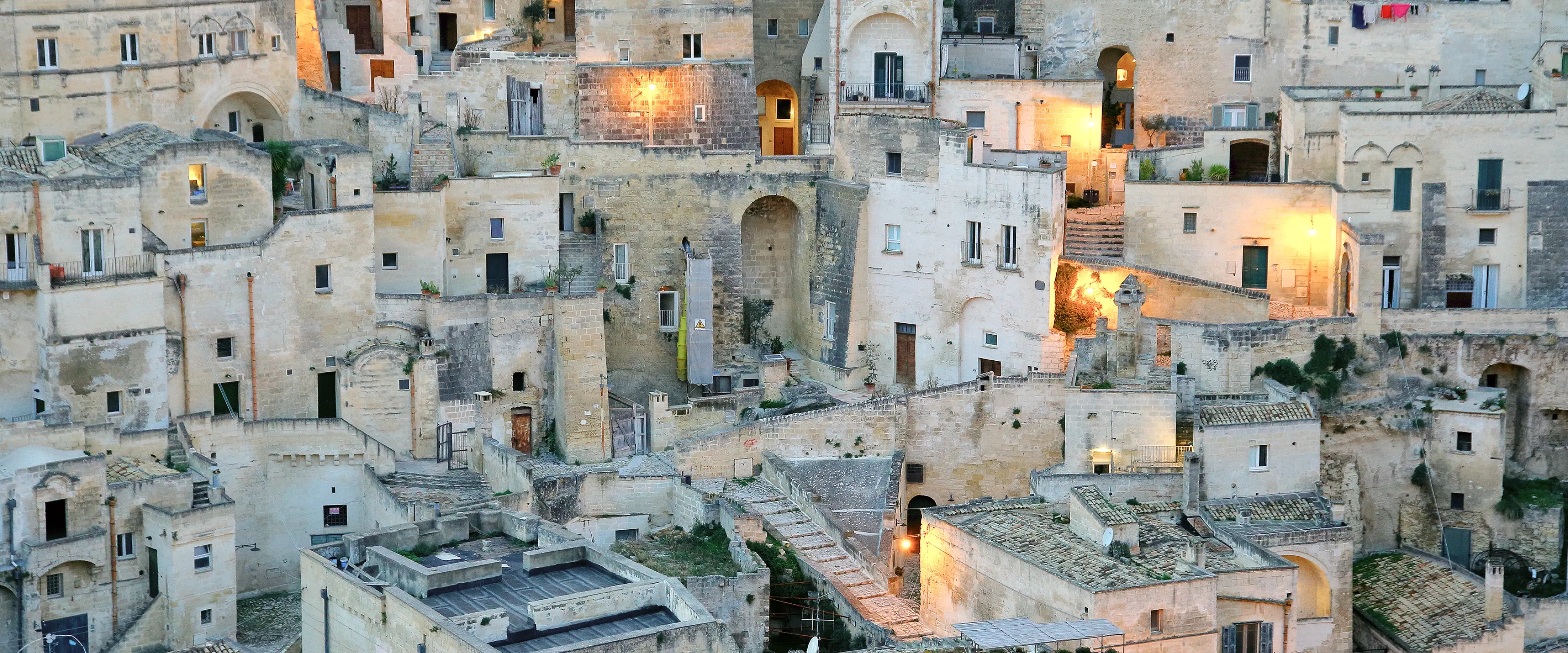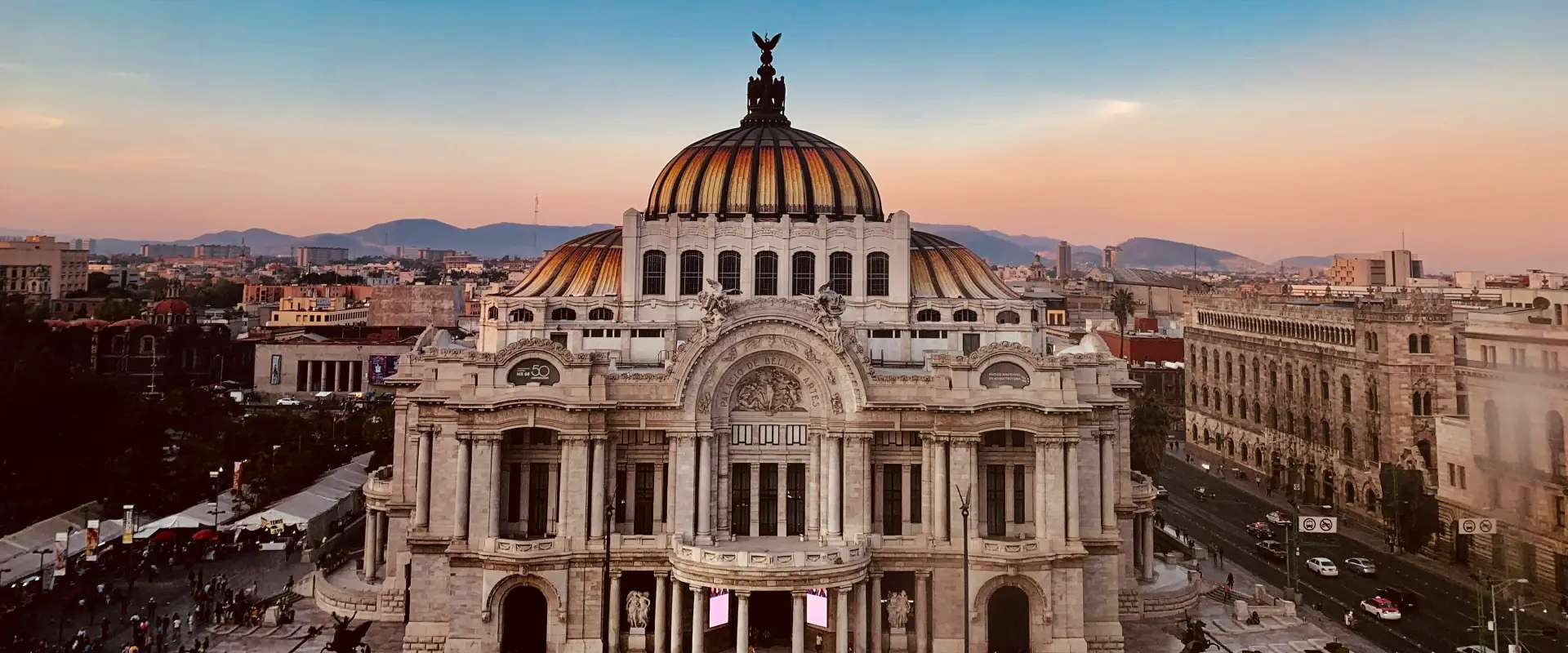
Matera: The Ancient Italian City Where You Can Sleep In a Cave
When you think of southern Italy, sparkling blue coves, beaches filled with striped umbrellas, and colorful seaside towns likely come to mind. Staying in a prehistoric cave dwelling might not be high on your list of things to do—but maybe it should be.
The ancient city of Matera, at the top of the boot’s instep, is a place truly unlike anywhere else on Earth. One of the oldest cities in the world, alongside Jericho and Aleppo, it has been the site of continuous human settlement for 10,000 years, dating back to the Paleolithic period. The city is built along the sides of a deep ravine pockmarked by natural caves, holes in the rock where early humans once dwelled. Looking out over the ravine, you can almost picture the hunter-gatherers perched in these nooks thousands of years ago.
Several civilizations have settled here throughout human history, layering ruins upon ruins. An archaeological dig in 1906 found Christian coffins from around 800 CE beneath the town center. Underneath that, Byzantine columns and statues from 400 CE were found, and beneath that, ancient Greek and Roman coins—and even further below, ceramic shards dating back 3,000 years.
What has resulted is a fascinating amalgamation of ancient and modern history: churches from the Middle Ages, prehistoric cave dwellings transformed into modern-day homes and businesses, and a maze of underground cisterns and interconnected passages that run underneath the cobblestoned surface.

Today Matera, a beige crush of limestone buildings rising up out of the ravine, is a dazzling sight to behold. The Civita, the town center, sits high on a hill, accented by the bell tower of the Duomo and surrounded by picturesque piazzas, quaint cafes and restaurants, and zig-zagging staircases and alleyways. Spread out below on either side of the hill are the Sassi, some 1,500 cave dwellings carved into the limestone seemingly stacked on top of each other at random, with streets often winding on top of houses. It is the Sassi, these unique cave homes, that have drawn the most attention to this remarkable city.
As recently as the 1940s, entire families, sometimes of 10 people or more, lived along with their pets and livestock crammed in the caves—often no larger than a small living room—in unsanitary conditions without plumbing or electricity. It had become a forgotten peasant’s village until 1945 when Carlo Levi’s memoir Christ Stopped at Eboli detailed the abject poverty and rampant disease he encountered there. Soon, the town became known as la vergogna nazionale (a national disgrace). In 1950, the Italian Prime Minister, appalled by the living conditions, began forcibly relocating all of the town’s 15,000 residents out of the Sassi and into modern housing developments.
But not everyone felt Matera deserved its poverty-stricken infamy. In 1959, a group of local students and friends, all between the ages of 20 and 30, formed a cultural society called Circolo La Scaletta. Called by “the conviction that they were not children of a city immersed in poverty, but of a place rich in history,” La Scaletta led the effort in researching, documenting, protecting, and promoting the incredible history and architectural wonders of Matera.

The group’s lobbying and restoration work of the ancient cave system began changing public sentiment: By the late '60s, even Carlo Levi himself declared the Sassi to be an architectural treasure “on a par with the Grand Canal of Venice.”
In 1993, UNESCO listed the Sassi as a World Heritage site, calling it “the most outstanding, intact example of a troglodyte settlement in the Mediterranean region.”
By 2019, the once-maligned city had gone through a total rebirth: It was named a European Capital of Culture, featured in several movies (Bond and DC Comics blockbusters, as well as biblical films), and was one of the fastest-growing tourist destinations in southern Italy.
Now, about half of the city’s labyrinthine grotte have been restored into livable homes, restaurants, art exhibits, shops, and even an underground swimming pool—all of which make for a wondrous place to explore for a couple of days.
Perhaps most notably, some of the Sassi have been transformed into stunning boutique cave hotels, aiming both to honor Matera’s history and attract tourism that benefits the city. Taking great care to preserve the original caves (and the two million-year-old fossils in the walls), they have been meticulously refurbished into rooms with all the amenities one would need to be comfortable: plush beds, bathrooms with deep soaking tubs, and simple furniture to hold your belongings. But the floors, walls, and vaulted ceilings are all made of thick slabs of cool limestone.
Aquatio Cave Luxury Hotel & Spa has more modern rooms with televisions and lighted vanities, plus a dreamy heated pool in a cavern. Sextantio Le Grotte Della Civita offers one of the more authentic—and unforgettable—cave dwelling experiences: minimalist suites, where turndown service includes lighting candles all over your room for a romantic welcome back to your cave. Breakfast is served in a 13th-century deconsecrated rupestrian (rock) church with a view out to the ravine.
Staying in a cave hotel may be one of the most unique accommodation experiences you’ll ever have. After a day of exploring this place so rich with history, it’s only fitting to experience a little of it for yourself. Watching the soft amber glow of candlelight dancing on the stone walls of your cave room, it’s hard not to ponder in quiet awe what life was like on this very site millennia ago.

Getting there
While nearby Puglia has become a popular tourist destination for its many photogenic attractions—golden beaches and rocky coves, vineyards, and whitewashed cities with traditional trulli houses—Matera is still often overlooked, despite being just a quick detour from the region’s other sights. Technically in the region of Basilicata, it is well worth the extra time (less than an hour drive from Bari (BRI), Puglia’s capital, and the nearest airport) to stop there for a night or two.
If you’d prefer not to drive (although highly recommended to be able to explore this beautiful part of Italy, especially without having to backtrack), you can take a train or bus from Bari to Matera.
If you’re coming from Naples, the best way to arrive is by car, which should take about three hours.
Average Going price for cheap flights to Bari: $473 RT
How to do it
- Best time to go: April to June and September to October see warm, moderate weather in Matera. The summer months of July and August are especially hot during the day, and there’s not much shade to be had in the city or the ravine. If combining the visit with a trip to Puglia or other parts of southern Italy, May and late September are optimal times to go, as you’ll likely find better hotel rates and fewer tourists.
- Cost: Aquatio Cave Luxury Hotel & Spa, €350 per night; Sextantio Le Grotte Della Civita, €500 per night
- Tips and considerations: Begin your visit at Casa Noha with an educational multimedia exhibit about the history of the Sassi. The Casa Grotta di Vico Solitario museum also gives an inside look at the cave homes, with period furniture and artifacts from when they were still occupied. Matera is the site of more than 150 chiese rupestri, rock churches hewn straight from the limestone, many filled with Byzantine art and ancient frescoes. Make it a point to visit at least a few of them, even if religious sites are not typically your thing. Santa Maria di Idris affords a breathtaking view of the Civita; go at dusk to see the city light up in an orange glow.
Last updated June 2, 2025
Articles you might like
View All
Our Favorite Things to Do in Mexico City: Hidden Gems and Must-See Spots in the Heart of the Capital
Dec 17, 2025
9 min read

Things To Do In London: Classic & Hidden Spots For a Complete Trip
Dec 16, 2025
13 min read

Things To Do in Orlando: The Ultimate Guide
Dec 9, 2025
10 min read






